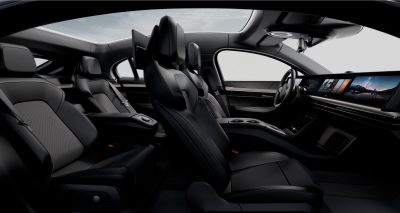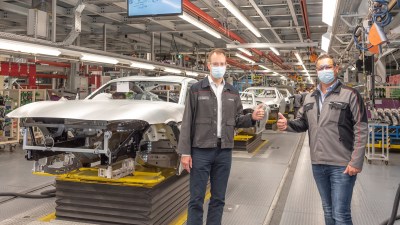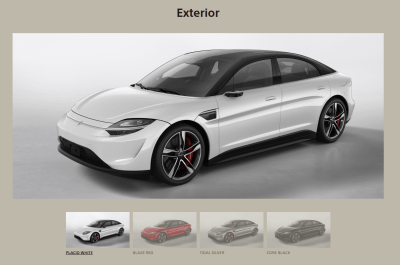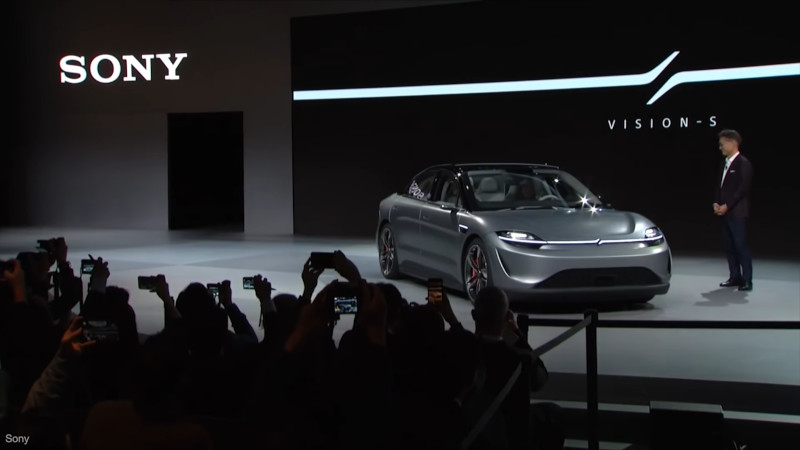Sony’s Electric Car Now Road Testing In Austria
The Consumer Electronics Show was not typically a place for concept cars, and Sony aren’t known as a major automaker. However, times change, and the electric transport revolution has changed much. At the famous trade show, Sony shocked many by revealing its Vision-S concept — a running, driving, prototype electric car.
Far from a simple mockup to show off in-car entertainment or new fancy cameras, Sony’s entry into the automotive world is surprisingly complete. Recently, the Japanese tech giant has been spotted testing the vehicle on the road in Austria, raising questions about the future of the project. Let’s dive in to what Sony has shown off, and what it means for the potential of the Vision-S.
Plenty of Swish Features
The Vision-S prototype boasts twin motors, one front and one rear, each delivering up to 200 kW at peak power. Combined with a roughly 2300 kg kerb weight and a reported 4.8 second zero-to-60 mph time suggest performance on par with Tesla’s Model 3. Interestingly, the company has kept its cards close to its chest regarding range or any specifications on the battery. Presumably, the battery pack uses cells of Sony’s own manufacture.

The vehicle is advanced inside and out, packing a suite of 40 sensors including CMOS cameras, LIDARs, ultrasonic sensors, and radar. With this package, Sony hope to enable the vehicle to deliver level 2 autonomy – wherein the vehicle can hold its speed and lane with driver supervision, akin to Telsa’s AutoPilot system. The goal is to eventually reach Level 4 autonomy, with the vehicle able to fully drive itself in select areas.
Much attention is paid to the in-car entertainment, which is unsurprising given Sony’s history in this space. Features include screens spanning the full width of the dashboard, as well as further displays for rear seat passengers. Each seat also gets its own set of speakers, which are intended to enable each passenger to listen to their own choice of content. One notable inclusion is that Sony aim for seamless transfer of audio from a driver’s smartphone earbuds to the car’s speakers when entering the car. Not a game changer, by any means, but something that highlights the seamless experience the company is going for.
Prototype or Production-Ready?

Sony has been working on the vehicle in concert with Magna-Steyr, a contract manufacturer of automobiles based in Graz, Austria. Currently, the company is producing a range of vehicles, from the combustion-engined Mercedes G-Class to the hybrid BMW 5-series and fully-electric Jaguar I-Pace. The collaboration has lent great credibility to the project, with the company’s long experience in automotive production serving as a base for Sony’s technological exploration.
Unlike the Apple Car, around which rumors have swirled for years with no real product spotted, Sony’s Vision-S appeared on the CES stage fully formed in 2020 before further details came to light this year. However, doubts remain as to whether the car will enter production or public sale. Sony are not established as an automotive brand, with no dealership or parts network around the world. Additionally, building a prototype is a far cry from getting a vehicle approved for sale in multiple jurisdictions around the world, which requires extensive testing, often destructive. The upfront costs for delivering a car to market are prohibitively expensive; as a particularly poignant example, Tesla took well over a decade to reach sustainable profitability.

It’s also difficult to see how well the Vision-S could fit into the marketplace. It’s unlikely Sony has automotive battery technology on par with Tesla’s latest innovations, let alone the factories required to produce them en masse for vehicles which require an incredible number of cells compared to the average consumer device.
Production plays a part, too. Magna-Steyr’s output is on the order of 200,000 cars a year, which is already split between several existing models and is unlikely to have much capacity to greatly expand that number for Sony. For contrast, Tesla built almost 500,000 cars in 2020 — 140,000 of which were the Model 3. Sony needs economies of scale to balance price and performance. Without a lot of hype or brand cachet in the automotive world, it’s a scary proposition to bet millions, if not billions, of dollars on.
A Rolling Testbed?
It’s perhaps likely that the project is instead Sony’s effort to invest in automotive technology. The Vision-S could instead serve as a testbed for Sony’s image sensors, LIDARs, and other technologies which it hopes to sell to existing automakers. By building their own vehicle which is representative of future market trends, they have a perfect engineering platform with which to experiment with. This is particularly useful when it comes down to the tricky engineering of actually integrating advanced hardware into a vehicle. Anyone can throw a bunch of expensive, off-the-shelf sensors on a roof pod and drive around with it; to create something practical, attractive, and cost-effective is a far harder task.
The car came as a shock to many; unlike projects at Apple and Google, there was little hype or expectation for a Sony car to exist. One wonders if a little more hype earlier on could have been useful to build market interest. The company’s website leaves things open to interpretation, stating that “This content and prototype vehicle are intended to illustrate our future concepts in the area of mobility.” It’s hard to bet on the project’s outcome either way, with the concept both seeming too polished for an internal engineering project, yet too poorly positioned to truly compete in the marketplace. It could even be the case that the project gets packaged up and sold wholesale to an existing automaker, with a new set of badges to hide its origins. Given several automakers like Mazda and Subaru are yet to show any serious efforts towards electrification, it could be the way to go. Regardless, we look forward to the next stage of development for this sleek and compelling vehicle — and wait with baited breath to see the impact it makes on the marketplace.

Post a Comment